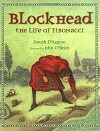|
Blockhead: The Life of Fibonacci

Last updated Tuesday, November 7, 2017
Author: Joseph D'Agnese
Date of Publication: 2010
ISBN: 0805063056
Grade Level: 2nd (GLCs: Click here for grade level guidelines.)
Date(s) Used: Nov. 2017
Synopsis:
As a young boy in medieval Italy, Leonardo Fibonacci thought about numbers day and night. He was such a daydreamer that people called him a blockhead.
When Leonardo grew up and traveled the world, he was inspired by the numbers used in different countries. Then he realized that many things in nature, from the number of petals on a flower to the spiral of a nautilus shell, seem to follow a certain pattern.
The boy who was once teased for being a blockhead had discovered what came to be known as the Fibonacci Sequence!
| Note to readers: |
| • |
A summary of Fibonacci's Life is on page 39. Consider reading it either before or after the main story.
|
| • |
Page 40 has great questions and ideas for discussion, actively re-reading the book.
|
| Discussion topics for before reading: |
| • |
Fibonacci like math- what are your favorite subjects in school?
|
| • |
Does anyone here have a nickname?
Vocabulary
|
| • |
Merchant:a person or company involved in wholesale trade, especially one dealing with foreign countries or supplying merchandise to a particular trade.
|
| • |
Numeral: a figure, symbol, or group of these denoting a number.
|
| • |
Pharaohs.: a ruler in ancient Egypt.
|
| • |
Abacus: an oblong frame with rows of wires or grooves along which beads are slid, used for calculating.
|
| Discussion topics for during/after reading: |
| • |
Can you think of a nicer nickname for Fibonacci- or anyone who loves math?
|
| • |
Leaning Tower of Pisa is on page 14- Ask the kids why they think its crooked?
|
| • |
Page 40 has several discussion + activity questions.
|
| • |
What was common shape that Fibonacci saw in nature? (spirals)
|
| Craft ideas: |
| • |
Create a cut out spiral out of paper. First, start your pen off in the middle of the paper, then create circles. Finally, cut out the spiral. (See Pinterest Board)
|
| • |
Draw the Leaning Tower of Pisa or create it with a toilet paper roll.
|
| • |
Check our craft ideas for on Pinterest!
https://www.pinterest.com/readingtokids/november-2017-crafts/
|
| Special activities: |
| • |
Write out the Fibonacci sequence on the board and explain to the kids how it works. (see pages 26-27)
|
| • |
Show the kids what number look like as Roman Numerals:
|
*Note: These craft ideas are just suggestions.
You can use them, but you don't have to use them.
You can expand upon them, or add your own twist.
Remember, though, that the focus of your time should
not be on the development and execution of a craft;
the focus should be on the read-aloud and the
enjoyment of the book!
|
